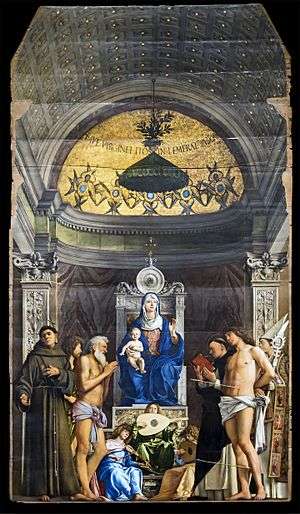San Giobbe Altarpiece
The San Giobbe Altarpiece (Italian: Pala di San Giobbe) is a c. 1487 oil painting by the Italian Renaissance master Giovanni Bellini, now in the Gallerie dell'Accademia in Venice.
| San Giobbe Altarpiece | |
|---|---|
 | |
| Artist | Giovanni Bellini |
| Year | c. 1487 |
| Medium | Oil on panel |
| Dimensions | 471 cm × 258 cm (185 in × 102 in) |
| Location | Gallerie dell'Accademia, Venice |
History
This altpiece is one of the masterworks of Bellini's mature period, and was painted for the second left altar of the church of San Giobbe in Venice. It was probably inspired by the San Cassiano Altarpiece (1475–76) by Antonello da Messina, and absorbed and further developed that work's innovations. Yet, as the dating of Bellini's painting is uncertain, such dependency cannot be proved. The work is among Bellini's most famous, a claim made as early as De Urbe Sito (1487–1491), a description of Venice by Marco Antonio Sabellico.

The depiction of Saints Sebastian and Job indicates that the painting might be created in connection with the plague probably that of 1487. The dating of the work is disputed, ranging from the early 1470s to the late 1480s. Jacopo Sansovino wrote in 1581 that the work for San Giobbe was Bellini's first using oil painting, which would imply an earlier date, nearer to Antonello's altarpiece. Yet, many scholars have disputed such claim.
The altarpiece remained in the church of San Giobbe until 1814–1818[1].
Description
The work can be read as an example of Holy Conversation: Mary sits on a tall marble throne, holding the Child; at her feet are three musician angels, while at the side are, in symmetrical positions, six saints. They are, on the left, Sts. Francis, John the Baptist and Job; on the right, Sts. Dominic, Sebastian and Louis of Toulouse. The child's feature are very similar to those in the Contarini Madonna, also housed in the Accademia Gallery.
 | |
The upper part features a perspective coffered ceiling, flanked with pillars which are copies of the real ones at the original altar. Behind the Madonna is a dark niche. In the latter's half-dome is a gilt mosaic decoration in the Venetian style.
By including traditional Venetian and Byzantine architectural elements in the scenery of the altarpiece, he is able to please his patrons by incorporating established practices while simultaneously introducing new artistic elements to society. This altarpiece is an example of a pala altar, or a single-paneled altar, a technique first introduced to Venice by Bellini and heavily influenced by Antonello da Messina.[2][3]
References
- Rugolo, Ruggero (2013). Venise – Où trouver Bellini, Carpaccio, Titen, Tintoret, Véronèse (in French). Scala. p. 12. ISBN 9788881173891.
- Peter Humfrey et al, "Bellini Family," Grove Art Online, Oxford Art Online, Oxford university Press (2003), https://doi.org/10.1093/gao/9781884446054.article.T007643
- John T. Paoletti and Gary M. Radke, Art in Renaissance Italy. (Upper Saddle River, NJ: Pearson Prentice Hall, 2012), 322–326.
External links
| Wikimedia Commons has media related to Pala di San Giobbe by Giovanni Bellini. |
Sources
- Olivari, Mariolina (2007). "Giovanni Bellini". Pittori del Rinascimento. Florence: Scala.
- Nepi Sciré, Giovanna & Valcanover, Francesco, Accademia Galleries of Venice, Electa, Milan, 1985, ISBN 88-435-1930-1